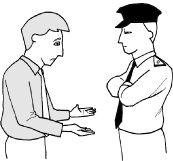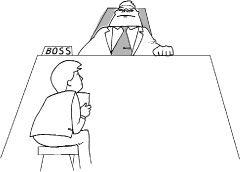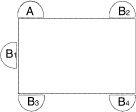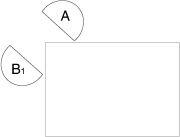The Definitive Book of Body Language (52 page)
Read The Definitive Book of Body Language Online
Authors: Barbara Pease,Allan Pease

It's possible to avoid intimidating others by consciously making yourself appear smaller in relation to them. Let's examine the body language of the situation in which you have committed a minor driving offense, such as failing to stop at a stop sign, not giving way, or speeding, and you are pulled over by the police. In these circumstances, the officer may regard you as an adversary as he approaches your vehicle, and most drivers' reaction is to remain in the car, wind the window down, and make excuses or deny the offense. The body-language negatives of this are:
The officer is forced to leave his territory (the patrol car) and come across to your territory (your vehicle).
Assuming that you are in fact guilty, your excuses may represent an attack to the officer.
By remaining in your car, you create a barrier between yourself and the police officer.
Considering that under these circumstances the police officer is in the superior position to you, this behavior serves only to make things go from bad to worse and your chances of getting a ticket are increased. Instead, try this if you are pulled over:
Immediately get out of your car (your territory) and go forward to the police officer's car (his territory). In this way he is not inconvenienced by having to leave his space. (Don't try this approach in the U.S.A. where getting out of your car and rushing toward an officer may result in sudden lead poisoning.)
Stoop your body over so that you are smaller than him.
Lower your own status by telling the officer how irresponsible you've been and raise his status by thanking him for pointing out your mistake and telling him that you realize how difficult his job must be, having to deal with fools like you.
With your palms out, in a trembling voice, ask him not to give you a ticket. If you're female and the officer is male, smile a lot, blink your eyes repeatedly, and talk in a higher-pitched voice. If you're a man, just take the ticket and pay it.

“Please don't book me!”
This behavior shows the police officer that you are not a threat and encourages him to take the role of a reprimanding parent, in which case he may decide to give you a stern warning and tell you to be on your way—without a ticket! When this technique is used as directed, it can save you from being booked in up to 50 percent of instances where a police car pulls you over.
The same technique can be used to calm an irate customer who is returning faulty goods to a retail store or wants to complain about something. In this case, a store counter represents a barrier between the store staff and the customer. Control of an irate customer would be difficult if the staff remained on their side of the counter, and created a “you-versus-me” approach, which can make the customer even angrier. If the staff member moves around to the customer's side of the counter with his body stooped over and palms visible and uses the same technique we used with the police officer, it can usually placate an angry person. Staying behind a desk or counter can raise anger levels.
Polish anthropologist Dr. Boguslaw Pawlowski found that—in an ideal relationship—trust, money, and respect are less important than the height difference ratio 1 to 1.09. His study in 2004 found that, to ensure marital bliss, a man needs to be 1.09 times taller than his partner. This formula fits in the case of failed romances, for instance, Nicole Kidman (five feet eleven inches) and Tom Cruise (five feet seven inches).
Couples who fit this success ratio include the following:
Cherie Blair and Tony Blair = 1.10
Victoria Beckham and David Beckham = 1.09
Those who technically fail the test ratio include:
Some Strategies for Gaining Perceived HeightCamilla Parker-Bowles and Prince Charles = 1.01
Penny Lancaster and Rod Stewart = 0.97
If you are a shorter person, there are several strategies you can employ to neutralize the power of taller people who set out to intimidate you. This is important if you are a woman because women are, on average, two inches shorter than men. Set up a space where you can control the environment by having chairs of varying heights and ask tall people to sit on the lower chairs. Sitting neutralizes height and sitting the Incredible Hulk on a low sofa diminishes his perceived power. Sitting at opposite ends of a table also evens things up, as does leaning in someone's office doorway to talk while they are seated. Talking in a public place, such as a bar or in a crowd, or in a car or plane, also limits the tactics of taller associates. If someone is overbearing or standing over you while you are sitting, get up and walk over to a window and gaze outside as you discuss an issue. You will look as if you are giving deep consideration to the discussion and the bigger person can't have a height advantage when you aren't looking at them. Finally, acting assertively can also minimize height differences. These strategies will put you “head and shoulders” above the height intimidators and let you “stand tall” among those who try to “get one up” over you.
Height differences have a significant impact on relationships, but height and power are often just perceptions. Shorter people can increase their perceived height and are more likely to be remembered as taller when they wear dark-colored clothing, pinstriped suits or trouser suits, softer, more muted makeup (for women), and full-size chronograph watches. The smaller the watch size, the less clout a person is perceived to have. Standing erect, sitting up straight, and “walking tall” are ways of giving yourself a confident appearance and, because of the law of cause and effect, you will feel more confident when you do these things.
SEATING ARRANGEMENTS—
WHERE TO SIT AND WHY

“Just feel at home and tell me all about it!”
Where you sit in relation to other people is an effective way of obtaining cooperation from them. Aspects of their attitude toward you can also be revealed in the seating position they take relative to you.
We conducted surveys with seminar delegates during the 1970's, 1980's, and 1990's to determine which positions at a table they felt gave the best result for communicating specific attitudes. We did this by delegate involvement at seminars and by using survey questionnaires from our database. The first major study in seating positions was conducted by psychologist Robert Sommer from the University of California, who analyzed a cross section of students and children in public and social situations such as bars and restaurants. We applied Sommer's findings to seating positions in business and negotiation situations. While there are marginal differences between cultures and the relationships between people, we have summarized here the seating positions you will encounter most of the time in most situations.
In his book
NonVerbal Communication in Human
Interaction
, Mark Knapp from the University of Vermont noted that, although there is a general formula for interpretation of seating positions, the environment may have an effect on the position chosen. Research conducted with middle-class people showed that seating positions in public bars can vary from the seating positions taken in a high-class restaurant. The direction the seats are facing and the distance between tables can also have a distorting influence on seating behavior. For example, intimate couples prefer to sit side by side wherever possible, but in a crowded restaurant where the tables are close together this is not possible and the couples are forced to sit opposite each other in what is normally a defensive position.
Keeping that in mind, we'll now present the main seating choices we have in a variety of circumstances at work and socially.
Let's assume that you are going to sit at a rectangular table with person A and that you are person B. Which seating position would you choose in the following circumstances:
You will interview someone for a job in a small, friendly company.
You are going to help someone complete a crossword puzzle.
You are going to play chess against someone.
You are in a public library and don't want any involvement.
Look at the next illustration and make your choices.

Basic seating positions
Here are your most likely answers:
You took B1, the Corner Position, to conduct the interview, as this allows you to see the person clearly without seeming competitive or aggressive, as you might in B3, or too familiar as in B2.
You sat in position B2, the Cooperative Position, to help with the crossword puzzle, because this is where we sit to give help or build rapport.
You chose position B3 to play chess against the person. This is called the Competitive/Defensive Position and is the one we choose to compete against an adversary because it lets us have a full view of their face and what they're doing.
Finally, you used the Diagonal Position, B4, in the library to communicate your independence or noninvolvement.
This position is used by people who are engaged in friendly, casual conversation. It allows for good eye contact and the opportunity to use numerous gestures and to observe the gestures of the other person. The corner of the desk provides a partial barrier in case one person begins to feel threatened, and this position avoids territorial division of the table. This is the most successful strategic position from which person B can deliver a presentation, assuming that person A is the audience. By simply moving the chair to position B1 you can relieve a tense atmosphere and increase the chances of a positive outcome.

The Corner Position